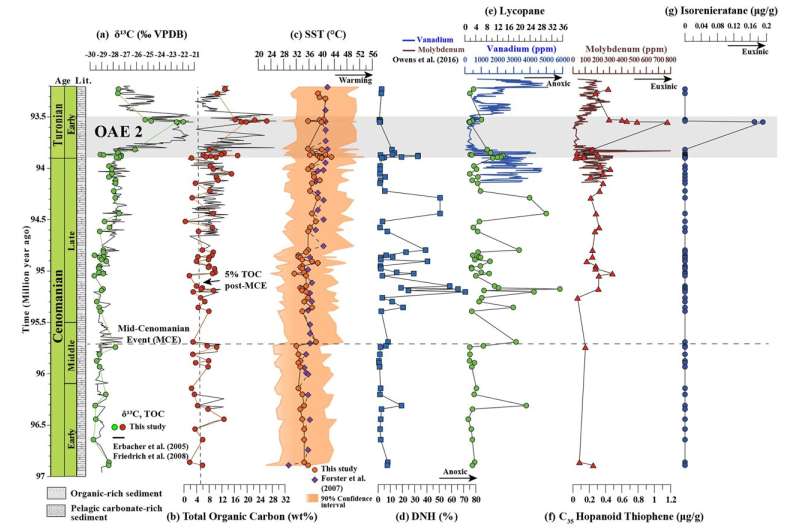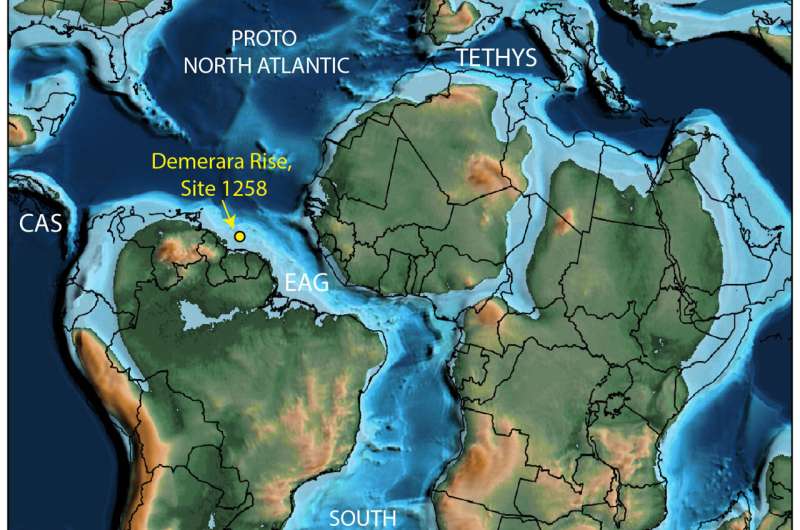January 30, 2024 feature
This article has been reviewed according to Science X's editorial process and policies. Editors have highlighted the following attributes while ensuring the content's credibility:
fact-checked
peer-reviewed publication
trusted source
proofread
Global warming caused widespread ocean anoxia 93 million years ago, deep-sea sediments research suggests

Marine anoxia is characterized by the oceans being severely depleted in dissolved oxygen, making them toxic and thus having devastating impacts on the organisms inhabiting them. One such event, known as Oceanic Anoxic Event 2 (OAE2), occurred ~93.5 million years ago across the Cenomanian-Turonian boundary of the Upper Cretaceous and lasted for up to 700,000 years.
During such scenarios, organic matter is buried at an elevated rate, producing distinctive layers of black shale in the geological record, which are depleted in the isotopically-heavier carbon-13, therefore generating a positive carbon isotope excursion of ~6‰ for this study period.
The specific factors triggering OAE2 are still debated, but the most widely supported is volcanism from the Caribbean Large Igneous Province and High Arctic Large Igneous Province, increasing atmospheric carbon dioxide and therefore warming the planet.
Among the plethora of impacts from a warmer planet is increased weathering of land, with fluvial processes transporting this material to the oceans, providing key nutrients to primary producers in the surface ocean. Enhanced primary productivity produces more oxygen, but trophic food chains ultimately use up more of this oxygen in their metabolic processes.
Compounded by decreased solubility of oxygen in warmer oceans, this results in widespread deoxygenation of Earth's marine realm, the focus of new research published in Climates of the Past.
Dr. Mohd Al Farid Abraham, of Universiti Malaysia Sabah, Malaysia, and colleagues turned to deep-sea sediments drilled during an explorative expedition of Demerara Rise, equatorial North Atlantic Ocean, which during the Cenomanian was located at a latitude of ~5°N.
Revealing the significance of the work, Dr. Abraham said, "Our research delves into the ancient oceans' secrets, specifically a period 93.5 million years ago when much of the ocean was devoid of oxygen. By studying natural chemical fingerprints preserved in marine sediments, we uncover how volcanic activities and climate warming in the past led to drastic ocean deoxygenation. Understanding this in deep time is crucial, as they mirror the challenges we face today with the ongoing climate crisis, helping us predict and mitigate future consequences."
Taking samples of organic matter from the drilled cores, the research team isolated compounds of biological origin that are stable over geological time periods of millions of years, known as biomarkers. Dr. Abraham explains that biomarkers are known as "molecular fossils," adding, "Biomarkers are chemical compounds found in sedimentary rocks that originated from living organisms millions of years ago. Think of them as molecular fossils that, unlike bones or shells, are not easily visible to the naked eye. These compounds, once part of living organisms, have remained chemically stable over vast geological timescales.
"We extract them carefully using a series of chemical procedures and a technique known as gas chromatography–mass spectrometry in the lab to isolate these compounds from the drilled sediments and to avoid contamination.
"Analyzing these biomarkers helps us reconstruct past environmental conditions, such as temperature and oxygen levels in the oceans, but linking their presence to specific historical environmental conditions requires meticulous laboratory work and a profound understanding of geochemical processes."
The scientists found that the percentage of total organic carbon content of the samples increased through the study period (3.8 million years), peaking at ~28 weight % at OAE2 from initial levels of 1–17 weight %. This occurred alongside a ~5-8°C increase in sea surface temperature up to ~43°C.
Key biomarkers of 28,30-dinorhopane and lycopane are indicative of this warming and decline in oxygen, forming an oxygen minimum zone in the Cenomanian, similar to those observed in the Black Sea today. This data is coupled with a noticeable reduction in the abundance of benthic foraminifera (bottom ocean-dwelling single-celled microorganisms) in the late Cenomanian, as they were not able to survive in the depleted-oxygen environment.

Such persistent low-oxygen layers increase in number and size with enhanced warming of the oceans, forming a thick zone at depth below a highly productive thin surface layer that is oxygen-rich. Biomarkers of C35 hopanoid thiophene and isorenieratane reveal this water-column euxinia (both anoxic and sulphidic) expanded to finally reach the surface photic zone through the Cenomanian-Turonian boundary at OAE2.
Movement of water masses, such as the Tethys Sea displacing warm saline Demerara Bottom Water, likely played a role in distributing nutrient-rich but oxygen-poor conditions across the ocean basin. Previous research has suggested that up to 50% of Earth's oceans ~93 million years ago were anoxic during OAE2, with this process beginning potentially ~2 million years earlier during the Mid-Cenomanian Event.
Eventually, this oceanic anoxic event came to an end, a cessation that Dr. Abraham and colleagues attribute to the exhaustion of nutrient supply in surface waters, which led to a collapse in primary productivity. Additionally, the termination might have been influenced by changes in the paleogeography of the Equatorial Atlantic Gateway. This gateway, which emerged between what are now northeast South America and west Africa, altered ocean circulation in the North Atlantic, thereby preventing it from becoming a nutrient trap that could support primary productivity.
Looking ahead to the future of Earth's oceans with the expansion of oxygen minimum zones, Dr. Abraham says, "In today's world, oceanic conditions are generally hypoxic but have not yet reached anoxic levels in open oceans. However, closed basins or seas are more prone to becoming anoxic.
"With ongoing global warming, it is predicted that oxygen minimum zones will expand both horizontally and vertically. Warmer water holds less oxygen, and increased surface temperatures can lead to stronger stratification of ocean layers, thereby reducing the mixing that normally replenishes oxygen in deeper waters.
"Additionally, global warming can enhance biological activity in surface waters, resulting in more organic matter sinking to the depths, where it consumes oxygen as it decomposes, a process evident during OAE2.
"Today, oxygen minimum zones are primarily found in the Pacific and Indian Oceans, with conditions making life hard for many marine species. With the current trends of global warming, these zones are expected to expand, reducing habitable marine space and adversely affecting marine biodiversity and fisheries.
"By the end of this century, if the current trajectory of warming and nutrient runoff continues, we might see a significant increase in anoxic and euxinic conditions in our oceans, threatening marine ecosystems and the services they provide to humanity."
Understanding the role that warmer oceans may play in the cycling of oxygen and nutrients through the water column is crucial, especially as Earth's oceans are entering an uncertain future due to ongoing climate change. Ancient episodes of marine anoxia (such as OAE2) teach us about Earth's history and remind us how vital it is to take care of our oceans. As we face new challenges with the climate, looking back at these past events can guide us to make better decisions for our planet's future.
"It is fascinating yet alarming how history is echoing in our current environmental crisis," Dr. Abraham states.
"The ancient oceans tell a tale of resilience and rebirth, but also offer a warning. The OAE2 event, although taking place over millions of years, shows us the profound impact that changes in the atmosphere can have on marine life. As we face our own climate challenges, it is more important than ever to heed these lessons from the past. Our research is not just about understanding history; it is a crucial part of the puzzle in safeguarding the future of our planet's oceans."
More information: Mohd Al Farid Abraham et al, Warming drove the expansion of marine anoxia in the equatorial Atlantic during the Cenomanian leading up to Oceanic Anoxic Event 2, Climate of the Past (2023). DOI: 10.5194/cp-19-2569-2023
Journal information: Climate of the Past
© 2024 Science X Network





















